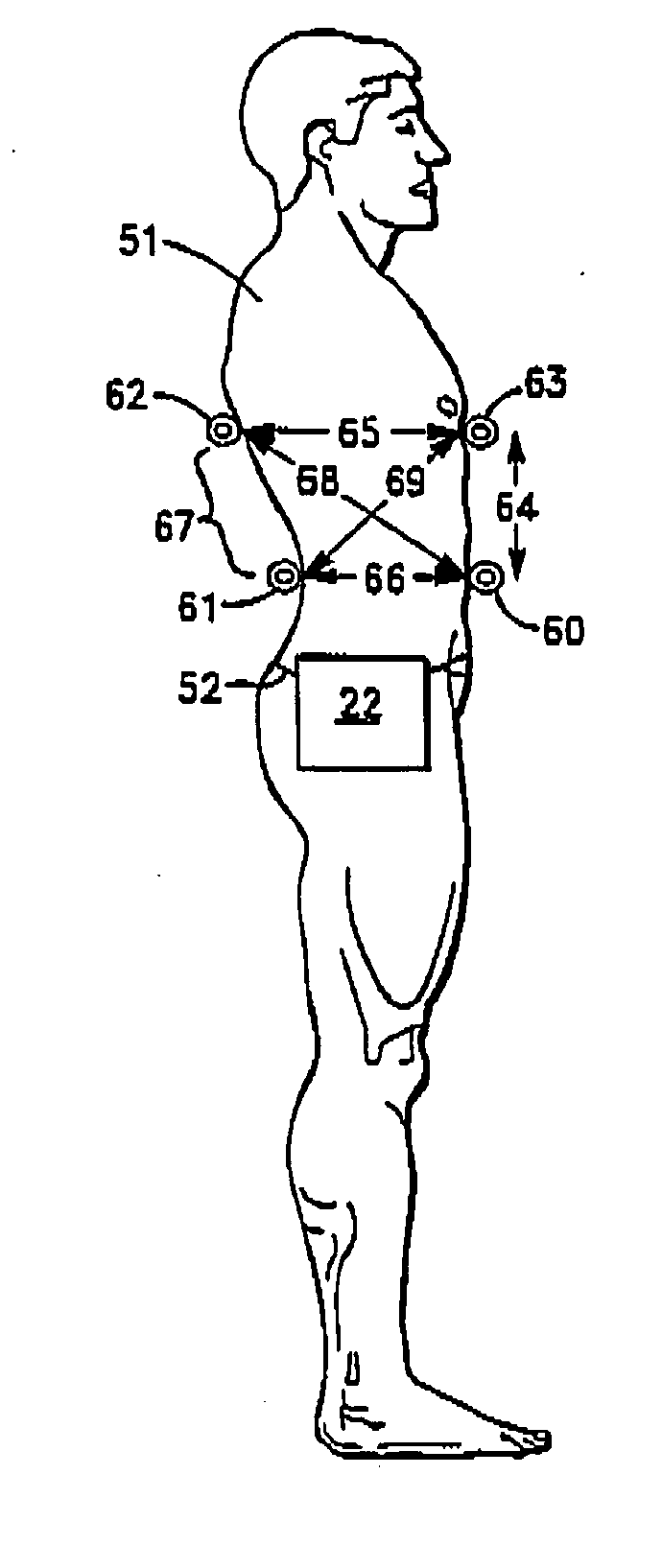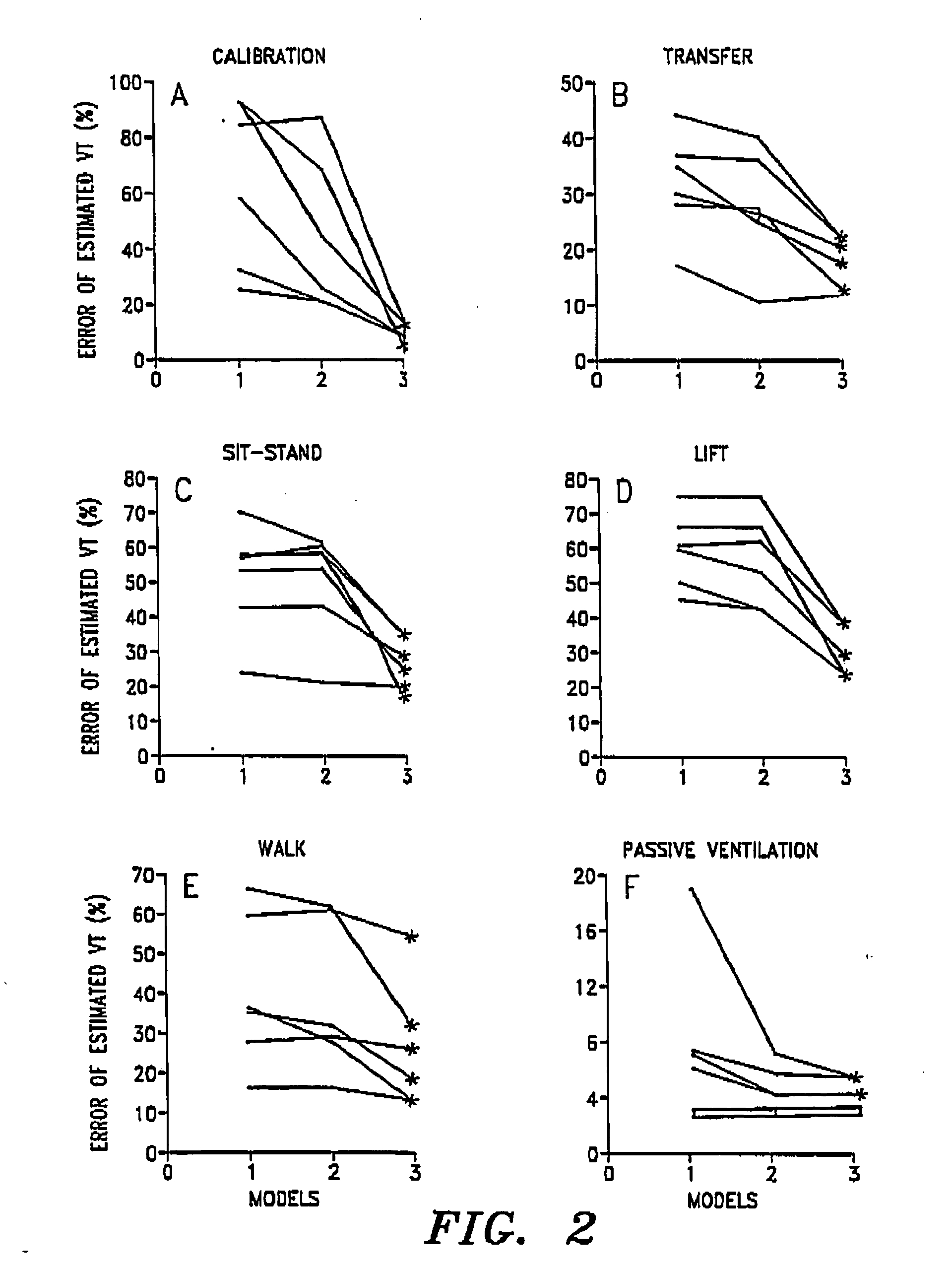Noninvasive method and system for measuring pulmonary ventilation
a pulmonary ventilation and non-invasive technology, applied in the field of measuring respiratory air volume in humans, can solve the problems of restricting breathing, difficult to use the mouthpiece for long-term subject monitoring, and employing a mouthpiece, and achieve the effect of expanding the rib cage and accurately detecting respiratory events
- Summary
- Abstract
- Description
- Claims
- Application Information
AI Technical Summary
Benefits of technology
Problems solved by technology
Method used
Image
Examples
example 1
Subjects
[0218]Thirty (30) subjects were selected to assess the accuracy of the “three-degrees-of-freedom” model of the invention. As reflected in Table 1, ten (10) healthy subjects with no known history of sleep-disordered breathing and ten (10) obese subjects were studied while awake in the supine, right and left lateral decubitus positions. Ten (10) obese subjects with obstructive sleep apnea (obese sleeping subjects) were studied while unrestrained during a daytime nap.
TABLE 1Non-Obese AwakeObese AwakeObese SubjectsSubjectsSubjectsDaytime Nap+Subject(BMI)(BMI)(BMI)12052512304561327614942849405275934629403872334518273839921505610 253938Mean ± SD25.7 ± 3.446.7 ± 9.145.7 ± 1.0BMI: Body Mass Index
[0219]The non-obese, awake subjects comprised seven (7) males and three (3) females, age 28-49 yr. (mean age 30.2 yr). The obese, awake subjects comprised six (6) males and four (4) females, age 24-64 yr. (mean age 44.4 yr). The obese, napping subjects comprised five (5) males and five (5) f...
example 2
Subjects
[0246]The following study was conducted to assess the accuracy of the “three-degrees-of-freedom” model of the invention and a pulmonary ventilation or magnetometer system employing the subject model to detect apneas and hypopneas during sleep.
[0247]As reflected in Table 6, fifteen (15) subjects (10 males and 5 females) with variable degrees of clinical suspicion for obstructive sleep apnea (OSA) were selected for the study. The mean age for the group was 45.47±12.5 years (mean±SD). The mean body mass index for the group was 35.00±5.7 kg / m2.
TABLE 6Body Mass IndexSubjectAge(BMI)15032271283343343931530366484174029849289744310 343911 443412 383313 394614 464115 4631Mean ± SD35.00 ± 5.745.47 ± 12.5
Device and Measurements
[0248]The anteroposterior displacements of the rib cage and abdomen, as well as the axial displacements of the chest wall (i.e. Xi) were similarly measured using a light-weight, portable pulmonary ventilation system of the invention (also referred to herein as a m...
PUM
 Login to View More
Login to View More Abstract
Description
Claims
Application Information
 Login to View More
Login to View More - R&D
- Intellectual Property
- Life Sciences
- Materials
- Tech Scout
- Unparalleled Data Quality
- Higher Quality Content
- 60% Fewer Hallucinations
Browse by: Latest US Patents, China's latest patents, Technical Efficacy Thesaurus, Application Domain, Technology Topic, Popular Technical Reports.
© 2025 PatSnap. All rights reserved.Legal|Privacy policy|Modern Slavery Act Transparency Statement|Sitemap|About US| Contact US: help@patsnap.com



